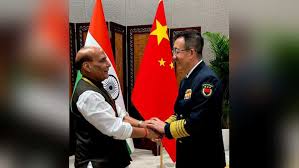‘Avoid new complexities in ties’: Rajnath Singh to Chinese counterpart during SCO Summit

Astana, Kazakhstan – June 2025: During the Shanghai Cooperation Organisation (SCO) Summit, India’s Defence Minister Rajnath Singh met his Chinese counterpart, General Dong Jun. He delivered a clear and firm message: avoid adding new complexities to an already tense bilateral relationship.
The meeting happened while military tensions continue along the Line of Actual Control (LAC). These tensions have remained unresolved since the Galwan Valley clash in 2020. Singh reminded China that normal ties depend on peace and stability along the border.
A Crucial Meeting on the Sidelines
The dialogue took place during the SCO Defence Ministers‘ meeting. Singh emphasized that peace at the border is essential for improving overall relations. He urged China to fully implement previous disengagement agreements and avoid actions that might escalate tensions.
India’s Defence Ministry said Singh clearly told China that respecting existing agreements is non-negotiable. Without this, restoring normal relations would be impossible. He stressed the need for trust, transparency, and consistent dialogue.
India’s Message: Dialogue, Not Concession
India is open to dialogue, but Singh made it clear that the country won’t accept territorial compromises. A senior Indian official said, “We want peace, but we will respond to any provocation firmly.”
This approach balances diplomacy with national security. India’s leadership is signalling that peaceful coexistence must be built on mutual respect and firm boundaries.
Background: Tensions Since 2020
The meeting follows several years of border tensions. In June 2020, 20 Indian soldiers and at least four Chinese troops died in the Galwan Valley clash. Since then, talks have made limited progress.
While some areas like Pangong Tso and Gogra saw partial disengagement, others like Depsang Plains remain tense. Indian officials remain wary of China’s activities along the border.
India’s SCO Focus: Stability and Cooperation
At the broader SCO meeting, Singh highlighted India’s commitment to regional peace and cooperation. He called on member states to adopt zero tolerance for terrorism, indirectly referring to Pakistan.
He also promoted rules-based international order and respect for national sovereignty, two core principles of India’s foreign policy. Singh urged all nations to honour their commitments to peace and stability.
China’s Response: Diplomatic, Yet Unchanged
China’s official response to the meeting has remained cautious. Reports suggest General Dong Jun called for enhancing mutual trust and continuing communication. However, India remains concerned about China’s actions on the ground.
China continues to build roads, helipads, and support hubs along the LAC. In response, India has also increased its military infrastructure in high-altitude regions. Tensions remain despite public talk of peace.
India’s Strategic Posture Shifts
India has made it clear that the border issue cannot be ignored while other aspects of the relationship continue as usual. Trade between the two countries persists, but India has restricted Chinese investments and apps.
Meanwhile, India is strengthening ties with the United States, Japan, and Australia through forums like the Quad. These moves indicate a broader shift in India’s strategic focus.
Singh’s remarks at the SCO align with this shift. India will not separate trade or diplomacy from unresolved security concerns.
Outlook: Dialogue With Deterrence
Though no breakthrough emerged from the meeting, Singh’s message to China is significant. It signals a firm but measured approach. India seeks peace, but not at the cost of its national interests.
The situation along the LAC remains delicate. Military dialogue will likely continue, but lasting peace depends on mutual action and trust.
Conclusion
At the SCO Summit, Rajnath Singh sent a clear message to China: avoid further complications and honour existing commitments. India values peaceful relations, but expects the same seriousness in return. This interaction marks another step in a tense, complex journey toward stability in one of Asia’s most sensitive regions.






